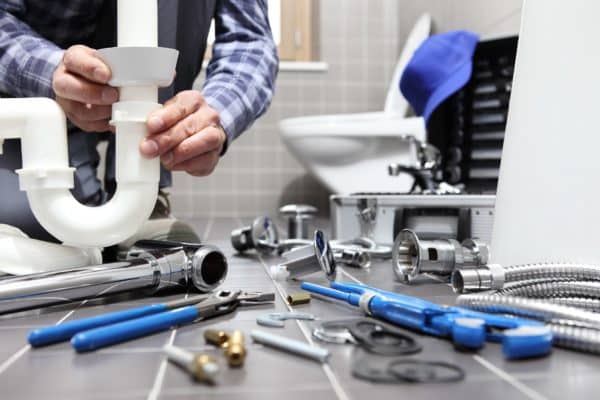Bidding plumbing work begins with selecting the right project to bid on. Bid lead sites like PlanHub can help plumbing contractors find projects that fit their plumbing services and skills in their geographical area. Next, you’ll review the bid documents for the plumbing job, perform a quantity plumbing takeoff, request quotes from your suppliers, estimate labor, add overhead and profit, and create your plumbing cost proposal.
Let’s take a more detailed look at the steps to bid plumbing work.
What is Construction Plumbing?
Construction plumbing is a specialized field that primarily deals with the water and sewage systems used during building construction. Plumbing contractors in construction ensure the proper conveyance of water inside and outside buildings, as well as the safe disposal of wastewater. This involves the installation of pipes, fixtures, and fittings in various parts of the structure, including bathrooms, kitchens, toilets, and other water usage points. Construction plumbers play a crucial role in guaranteeing that a building’s plumbing system operates efficiently and complies with safety and regulatory standards. Their expertise contributes to the overall functionality and comfort of the structure, making them essential contributors to the construction process.
1. Choose the right project
Before quoting a plumbing project for a plumbing system, you must know the best projects to bid for your company. This could be based on several factors, including the skill set of your employees and the location of the project. Similar to learning how to bid electrical work, make sure that you and your employees have the skills and knowledge to complete the work and bid it. This will ensure efficient construction productivity. If the project includes new work that you don’t have experience with, add some additional costs for the learning curve and possible mistakes. If the project is out of your service area, you also need to add housing and per diem for your employees. PlanHub can help you find more projects that fit your skills and location.
2. Review bid documents
You will most likely be responding to an invitation to bid (ITB), request for qualifications (RFQ), or a request for proposals (RFP). All of these will include documents that describe and show the scope of work to be performed, as well as describe how to perform it. The specifications provide information on the materials to be installed and how to install them. Pay special attention to Divisions 01 and 25. Division 01 provides information on qualifications, payment terms, bonding, insurance, etc. Division 25 provides specific information about the plumbing scope of work, including material and equipment specifications, installation methods, and who’s responsible for what costs.
3. Perform a quantity takeoff
A quantity takeoff or material takeoff is a count of the number of materials or equipment needed to complete the specified work. It includes things like lengths of pipe, valves, plumbing fixture, plumbing equipment, etc. To perform a takeoff, count the number or length of each material needed on the project and estimate the material cost. This can be done with the assistance of estimation software, an electronic scale, or a ruler and highlighter. When you are finished with the takeoff, you will have a complete list of each material, fixture, piping, or piece of equipment needed to complete the work.
4. Get quotes from suppliers
Once you’ve completed your material takeoff and have a list of products, send the list to your material supplier(s), along with the appropriate bid documents, to get a quote from them. You’ll want to do this as soon as possible because it may take a while for the supplier to put your quote together. Suppliers sometimes wait until just before a bid is due to release their quotes. This helps prevent bid shopping, which is when you go to another supplier to try to get a cheaper price.
5. Estimate labor
Next, you will use your material takeoff to estimate the amount of labor it will take to install each item or piece of equipment. The most common way to estimate labor is to use past project data. You’ll look at a project with similar scope and apply the labor required to the new scope of work. If you don’t have past project data to help you determine your labor hours, you can use a labor guide. Guides tell you how many hours on average it takes to complete a specified task. To determine your labor cost for the project, multiply the total number of labor hours required by your fully burdened labor rate. A fully burdened labor rate includes worker wages, employer taxes, and benefits, so it is important to research successful construction business models.
6. Add overhead and profit
Overhead includes expenses not directly related to performing the work, but that are required to keep your business running. It consists of things like administrative staff, insurance, marketing expenses, office rent and supplies, estimating and sales costs, etc. It is usually calculated by adding a percentage of total project costs. If you don’t know what your overhead percentage is, consult with an accountant. Profit is pretty self-explanatory and is usually calculated as a percentage of the total cost on the job.
7. Write your proposal
Your sales price for the project is calculated by adding up material costs, labor costs, overhead, and profit. You’ll want to create a standardized form for all your proposals to ensure you’ve included everything. For more information about what a proposal should include, see our article “What Should a Construction Bid Look Like?”. If you don’t have a standard proposal template, here’s one you can use.
8. Review your proposal
It’s always a good idea to have someone else review your proposal, math and all. Have them check your quantity takeoffs, as well as all math used to create the price. This is especially true if you’re using a spreadsheet with a sum formula. It’s very easy to miss a cell or two and quote the wrong price. Compare your price to past projects with similar size and scope to see if you are in the ballpark. If there is a large difference, there may be a problem with your quote. Also be sure to proofread your proposal and check formatting to ensure everything looks the way you want it to.
9. Submit proposal
Now it’s time to turn in your proposal. Make sure to use the bid form required by the bid documents or Division 01 specifications, if required. After you submit your bid, you may be asked to qualify it. This means you will be asked by the general contractor or project owner to confirm what scope of work your bid contains and what is excluded. You may also be asked to revise the scope of work and pricing to fit how the general contractor or owner is contracting the job. Both of these are regular occurrences and are no reason to panic.
When to Bid on a Plumbing Job?
Knowing when to bid on a plumbing job is a critical aspect of success in the plumbing business. It requires a strategic approach and careful consideration of various factors. Firstly, it’s essential to assess your team’s current workload and availability. If your schedule is already full, taking on additional projects might lead to overcommitment and compromise the quality of your work. Secondly, consider the project’s scope, complexity, and timeline. Evaluate whether your team has the expertise and resources to meet the client’s requirements within the specified timeframe. Additionally, analyzing the financial aspects, such as material costs and labor expenses, is crucial to determine if the project aligns with your budget. Stay informed about market conditions and industry trends to gauge the competitiveness of your bid. Ultimately, the decision to bid on a plumbing job should be a well-informed one, taking into account both the capabilities of your team and the strategic fit with your business objectives.
Free Plumbing Bid Template
One of the best ways to gain new plumbing work is to submit bids to customers. Softwares makes it incredibly easy to create a professional plumbing bid in minutes.
Tips and Best Practices for Plumbing Bids
- Be Qualified to Perform the Work Before You Bid
- Be Precise and Thorough With Your Estimates
- Make It Easy for Customers to Accept Your Bid
Finding the right job for you
In order to create and maintain a successful plumbing business, you must always be searching for new work. Construction bidding websites like PlanHub offer general contractor software free which helps you find the job you need in your area quickly and easily. Once you’ve found a job that fits your skills, use the steps above to write a winning proposal.
If you’re a plumbing subcontractor and you want to see how PlanHub can help you expand your business, contact us today.


